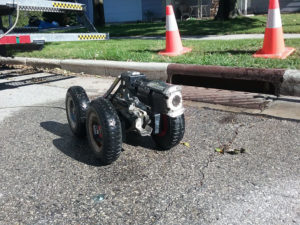We take proactive measures to improve the performance levels of our collection system. Televising is the most effective method to inspect the internal condition of a sewer. The main purpose of these inspections is to determine the condition of the pipe and if any blockages are present that may require cleaning, replacement, or repair. The inspections also help to detect any cross connections between sewers and help maintain compliance with state and federal regulations.
 Specially made waterproof cameras allow for a visual inspection of sewer lines and laterals that are underground. Using a camera takes the mystery out of what lies beneath. The crawler can be placed down a manhole and remotely driven from within the truck down the sewer to the next manhole. The entire length of a sewer line between two manholes can be examined. These cameras have pan and tilt capabilities which allow the operator to move the camera in all directions to obtain a thorough picture of the entire sewer line. This also allows for service connections to be located and documented.
Specially made waterproof cameras allow for a visual inspection of sewer lines and laterals that are underground. Using a camera takes the mystery out of what lies beneath. The crawler can be placed down a manhole and remotely driven from within the truck down the sewer to the next manhole. The entire length of a sewer line between two manholes can be examined. These cameras have pan and tilt capabilities which allow the operator to move the camera in all directions to obtain a thorough picture of the entire sewer line. This also allows for service connections to be located and documented.

We operate a closed circuit television (CCTV) truck which is equipped with cameras mounted on a robot crawler that relays live footage from within the sewer to a monitor in the truck via CCTV. Documentation of inspection is critical to a successful operation and maintenance (O & M) program.

A footage counter is connected to the camera, enabling the operator to note the exact location of any service connections or problems. The camera also transmits video back to the CCTV truck that can be recorded for future use.
The Fond du Lac Water Utility has a Cross-Connection program to help eliminate possible contamination of the public water distribution system. As part of this program, an inspection of residential properties is to be completed. Inspectors review your water system for connections that could possibly contaminate the water distribution system. There are no fees for the inspection, however, any costs associated with the replacement or modification, installation, and/or testing of backflow prevention devices or assemblies are the responsibility of the property owner/manager.
